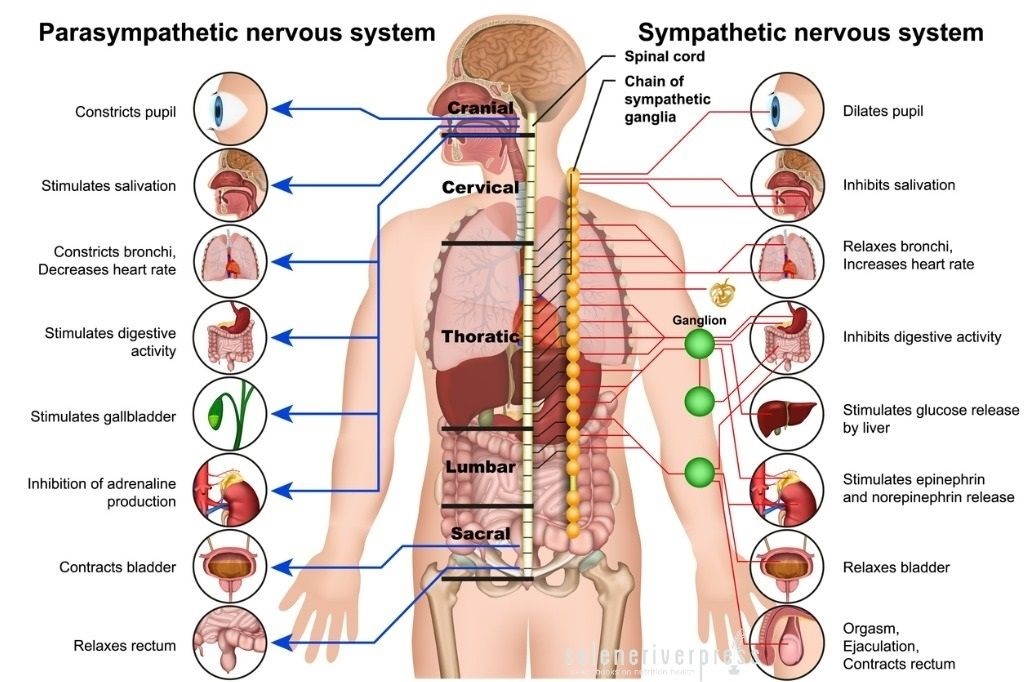For too many years, it seems we’ve all been reading articles on the parasympathetic and sympathetic nervous systems, which together comprise the autonomic nervous system (ANS). However, though we are told that the ANS is important to our health, we don’t take the time to follow up and actually learn why. Sound familiar? Well, at one time I too was like this. Though I knew it was important, I couldn’t follow the intricate explanations on why. Everything I read would quickly descend into the complexity of the ANS. In fact, to most people it is the Rubik’s cube of the body!
Luckily, I found a great way to help the average person understand this issue as well as other complex health topics. (See my “Afterthoughts” segment at the end of this article for a complete list.) I hope this post will also help health practitioners pinpoint why many of their clients frequently complain of feeling either low-key and sluggish or anxious and rushed, even while experiencing no other detectable health difficulties.
These disorders are medically described as hypo (low-key/sluggish) or hyper (anxious/rushed). If you want to learn what makes the parasympathetic and sympathetic nervous systems (which are both part of the ANS, as I mention above) so important to your health—without being overwhelmed by a lot of medical jargon—please keep reading.
Giving Credit Where Credit Is Due
Before I go on to detail the intricacies of the parasympathetic and sympathetic nervous systems, let me introduce you to the source of my information—a blog post titled “Dr. Gaeta on Tachycardia” by Dr. Michael Gaeta, which I discovered in the weekly SRP newsletter. (You too can receive this wonderful newsletter. Simply scroll down to the bottom of the SRP homepage and enter your email address. It will be delivered right to your inbox each week!)
Wanting to learn more, I decided to order one of Dr. Gaeta’s video seminars, The Six Core Principles of Trophotherapy—A Review of Mark Anderson’s Back to School for Doctors 2014. In just over five and a half hours, Dr. Gaeta covers numerous health conditions (which I have listed at the end of this post). In particular, he provides detailed information on the autonomic nervous system as well as its corresponding parasympathetic and sympathetic nervous systems—all in simple, easy to understand terms. After many years of trying to find a simple way to explain these issues to my clients, I was thrilled to finally understand it myself and thus be able help others. Wow, what a find!
What Does the Autonomic Nervous System Do?
As explained in this article, the autonomic nervous system “regulates a variety of body processes that take place without conscious effort. The autonomic nervous system is the part of the peripheral nervous system that is responsible for regulating involuntary body functions, such as heartbeat, blood flow, breathing, and digestion.”
In other words, as Gaeta states in The Six Core Principles of Trophotherapy, we don’t need to verbally command our lungs to breathe, breathe, and breathe. This is just one of the many things the body does automatically under the direction of the ANS.
The same article I quote above goes on to provide a general overview of the three branches of the ANS: the sympathetic, the parasympathetic, and the enteric.
- The enteric nervous system: “The autonomic nervous system is also made up of a third component known as the enteric nervous system, which is confined to the gastrointestinal tract.”
- The parasympathetic division: “Helps maintain normal body functions and conserves physical resources. This division also performs such tasks as controlling the bladder, slowing down heart rate, and constricting eye pupils.”
- The sympathetic division: “Regulates the flight-or-fight responses. This division also performs such tasks as relaxing the bladder, speeding up heart rate, and dilating eye pupils.”
My aim here is not to give you a total understanding of the nervous system but rather a basic understanding of these two nervous systems as detailed by Dr. Gaeta. This will hopefully help you detect if you are parasympathetic or sympathetic dominant. In addition, I will discuss how to find support and balance so you will not always feel either hypo (low-key and sluggish) or hyper (anxious and rushed).
In describing both of these systems, Dr. Gaeta uses specific terminology. The parasympathetic is “rest and digest,” while the sympathetic is “fight or flight.” But I’m sure you can identify the feelings that come with being dominant in one or the other. With this information in mind, you may be able to recognize if you have dominance, especially if you’ve been labeled as eccentric or straight out mentally unbalanced. (Smile) Perhaps you’re just over-tuned in one or the other. Allow me to help you learn how to stabilize them so you can experience life on a more even keel. No more pills to perk you up or calm you down!
 A Test to Help Determine Your Dominant State
A Test to Help Determine Your Dominant State
If you’re already certain that you are either parasympathetic or sympathetic dominant, you can skip the rest of this paragraph. If you aren’t sure, a Standard Process practitioner may be able to help you with a specific test called the Systems Survey Form (SSF). Once you fill out the form, your practitioner uses a key to help determine your particular health conditions based your answers.
In fact, the survey may even reveal health problems you were not aware of and which could require further treatment. Dr. Gaeta highly recommends the Systems Survey test, but your practitioner may also suggest other tests that are unique to their practice.
Key Minerals and Vitamins for Each Type of Nervous System
Once you watch Dr. Gaeta’s presentation, you will discover other informative recommendations that are too numerous to detail in this blog post. Nevertheless, I’d like to discuss Dr. Gaeta’s key mineral and vitamin recommendations for harmonizing the two nervous systems so they work in tandem. If one is dominant over the other, it will make your life miserable. Just remember the symptoms: hypo (low-key and sluggish) and hyper (anxious and rushed).
Parasympathetic recommendations. In this case making it through the day can be a battle, and you may wonder why you don’t meet your goals. You blame poor sleep, your job, family problems, and on and on. Some may even pop dangerous pills to get going, or drink too much coffee or other caffeinated drinks. With this type of nervous condition, Dr. Gaeta recommends the following:
- Key mineral: Phosphorous. According to Dr. Gaeta, a good source of phosphorous is Phosfood Liquid from Standard Process. (Caution: Phosphorous combines with calcium to form bone. If bone is not needed, the body will eliminate the phosphorous. If you use Phosfood Liquid for ANS support, take it an hour before or after a meal to avoid it being eliminated.)
- Key vitamin: B complex. Dr. Gaeta recommends Cataplex B-Core from Standard Process.
Sympathetic recommendations. In this case you are more than likely going in all directions. Unable to finish projects, easily angered, fearful and anxious about things you have no control over. You may frequently wake up in the middle of night and can’t fall back to sleep. You may seek a solution with a sedative, medical or natural, to help calm down. With this type of nervous condition, Dr. Gaeta recommends the following:
- Key mineral: Potassium. Dr. Gaeta’s recommendation for potassium is E-Z Mg or Organically Bound Minerals from Standard Process.
- Key vitamin: The calming G complex (the B2 range of the B complex). Dr. Gaeta recommends Cataplex G from Standard Process, which has a very calming effect on the nervous system.
Adjusting Your Diet with These Minerals and Vitamins
It is always a good idea to get the nutrients you need from the food you eat. Standard Process nutrient supplements are whole food concentrates that have a therapeutic effect. However, if you obtained the right amount of the nutrients you need from your food, you would not need these supplements in the first place. As a nutritionist, I know the power of whole organic foods. This is why I encourage you to enrich your diet with foods that contain the same minerals and vitamins as the supplements your practitioner recommends to you. That said, the following links will take you to more resources on foods that are rich in the recommended minerals and vitamins:
- Food sources of phosphorous.
- Foods rich in the vitamin B complex.
- Foods rich in potassium.
- Food sources of the vitamin G complex.
Whole food supplements are meant to support the systems involved, but they are even more effective when taken in tandem with a healthy, nutrient dense diet. Standard Process supplements can accomplish the therapeutic result you need because they are: 1) specifically concentrated and formulated to address the condition; and 2) thoroughly tested to get the results that Dr. Gaeta speaks about.
In closing, I encourage you to consider purchasing Dr. Gaeta’s valuable presentation. You will find helpful information on numerous other conditions in addition to the topics I discuss in this blog post.
[xyz-ihs snippet=”Begin-Authors-Note”]Afterthoughts from the Traditional Cook
As I mentioned earlier, here is a list of the other modules presented by Dr. Gaeta in The Six Core Principles of Trophotherapy. They are as follows:
- Holism and Reductionism
- The Triad of Digestion
- Liver and Gallbladder
- Celiac Disease
- Protein Digestion
- Lactic Acid
- Candida Albicans
- Colon Cancers and pH
- Exogenous immunity
- Autonomic Nervous System
- Cardiovascular
- Nutritional Complexes
- Resources and Next Steps
Disclaimer from Maria Atwood, CNHP: I am a Certified Natural Health Professional, CNHP, not a medical doctor. I do not diagnose, prescribe for, treat, or claim to prevent, mitigate, or cure any human diseases. Please see your medical doctor or health practitioner prior to following any recommendations I make in my blog posts or on my website.
Images from iStock/medicalstocks (main), SIphotography (tired man at computer), Nataliia Mysak (food), SIphotography (angry man).






